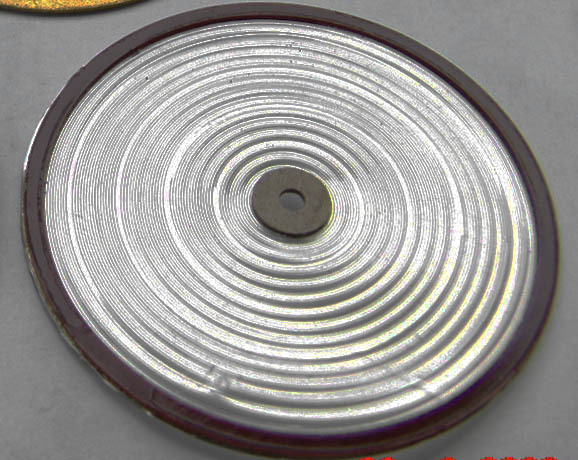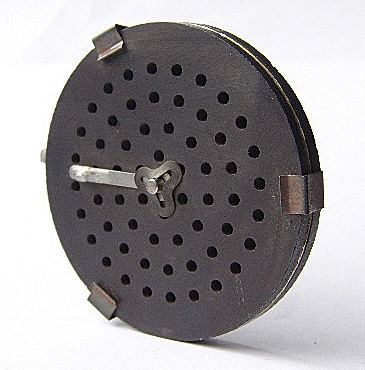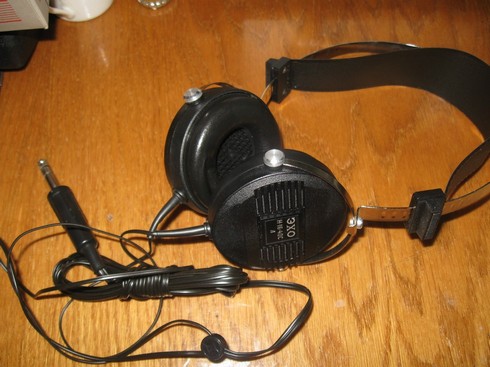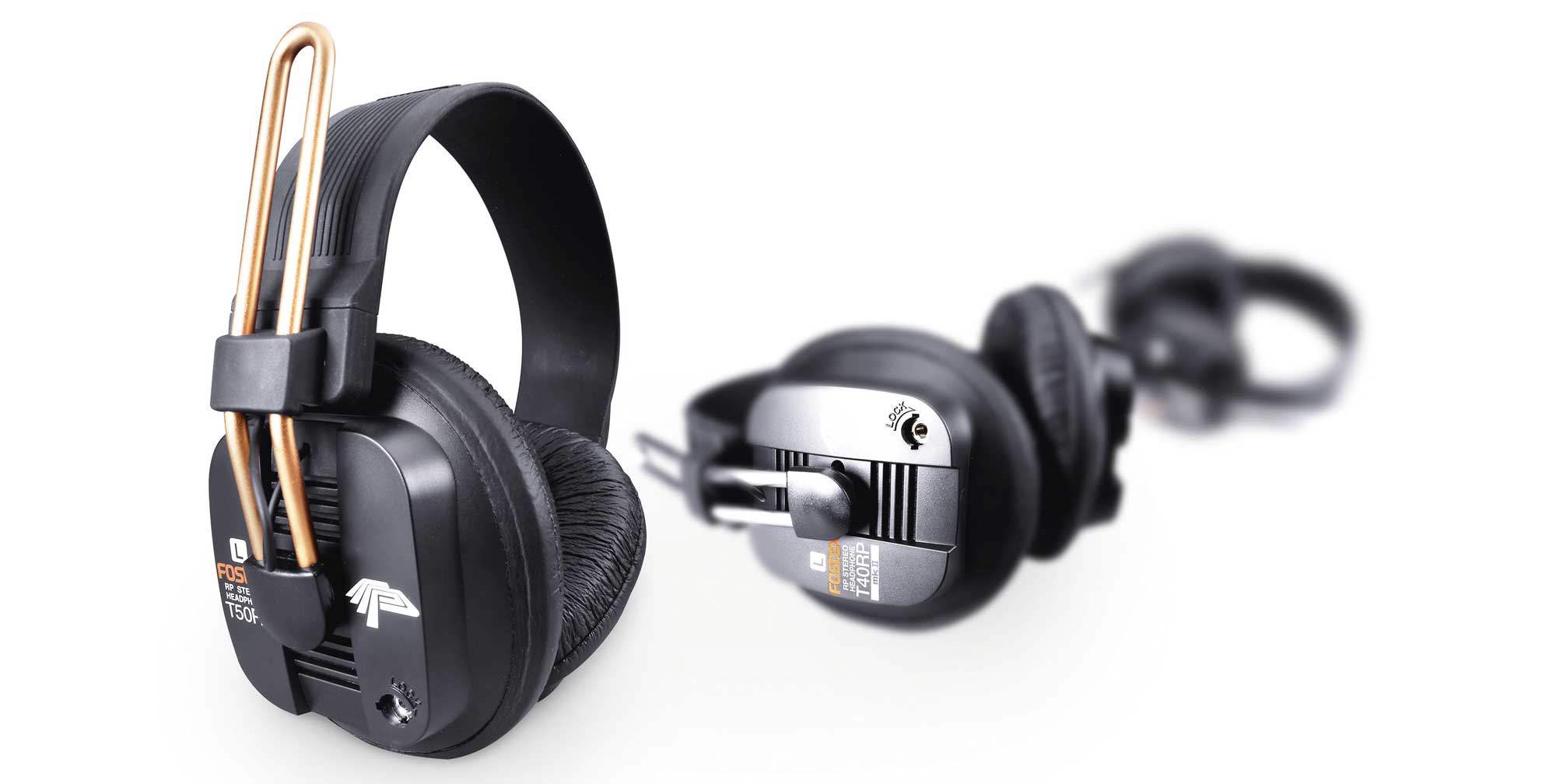Acoustics. Orthodynamic Emitters
Hello to all.
I want to tell a little about non-standard radiators.
Orthodynamic membranes were invented, like many good things, in Japan and have been used in many models by Yamaha, Audio Technica, etc. for a long time.
The structure of such speakers is both simple and complex. In fact, they are two round magnets and a membrane between them, which form a kind of sandwich.

Wishing to ask under the cat.
The trick of this technology is that they are magnetized in different ways, in different parts of the magnet.
Concentric circles, similar to the annual rings of trees, the areas of different poles cover the entire magnet, diverging from the center to the edges.
In the illustration, the south is marked in red, so you can almost imagine how this is all located.
We now turn to the membrane. Unlike a dynamic system, it is not a diffuser glued to a magnetic coil, but a thin membrane onto which a conductive path is applied by a spiral.

The tracks were applied either by etching a previously applied layer of metal foil, or by gluing a ready-made helix onto a mylar membrane. Lavsan with a film thickness of 5-8 μM had an extremely small weight, comparable to the weight of the air vibrated by the film.
When current was applied, the spiral generated an electromagnetic field, which began to interact with the permanent magnetic field of the pancake magnets, and as a result, it began to vibrate and generate sound.
The emitter itself looks like this:

')
This technology has one main advantage: due to the extremely small mass of the membrane membrane, the level of distortion is very low and approaches the ideal. This is a class Hi-Fi.
Orthodynamics was used almost exclusively in headphones, and was actually created for them as a modification of the earlier technology of isodynamic emitters.
The principle of operation of both technologies is fully described in the corresponding patent .
Now I want to argue why I attribute the headphones created on this technology to Hi-Fi.
- Orthodynamic headphones sound very accurate and true. There is no senseless tearing of the bass and tops, the middle does not squander at all.
- Due to the small inertia of the membrane, the microdynamics is impressive, all the smallest details of the sound are very well transmitted.
- The headphone power is very high (to be honest, it is excessive at maximum power, it is even very real to deafen).
Like any non-mass technology has its own subtleties.
Nuance 1. These headphones, almost certainly require a special headphone amplifier. Without it, they will also sound, but "not so."
Nuance 2. They require warming up. Seriously, if the headphones did not listen for a month, they would need 5 hours to achieve their perfect sound. With daily listening, 5 minutes of warm up is enough.
Nuance 3. The quality of the sound source must be very high, the quality of the recording too.
Nuance 4. They must be loved.
Nuance 5. When listening to modern recordings on these headphones, you need to understand that music is now recorded a little differently than it was done 30 years ago. The music in these headphones will sound completely different.
Nuance 6. Real gurus achieve an optimal sound for themselves by selecting the optimal amplifier and changing the damping of the headphones.
Nuance 7. Most headphones do not have a deep pitching bottom bass. Lovers of "brain removal" headphones can not deliver pleasure. At the same time, there are models that work through the entire range. In general, this is the so-called vintage sound.
The largest number of models produced in Japan by Yamaha. There was also a wide range of headphones in the USSR.
The latest headphones produced in the CIS were ECHO H-16-40 C made in the city of Smela.

The last models known to me are made by the Japanese company Fostex .

References:
Russian-language forum on headphones + its continuation
Current list of headphone models with isodynamic and orthodynamic emitters.
The article was compiled on the personal initiative of my beloved Echoes H-16-40, which I dreamed of and asked not to forget about them.
Thanks for attention.
ZY Earlier, I collected a collection of Soviet headphones, and sometimes I think of returning to it.
I want to tell a little about non-standard radiators.
Orthodynamic membranes were invented, like many good things, in Japan and have been used in many models by Yamaha, Audio Technica, etc. for a long time.
The structure of such speakers is both simple and complex. In fact, they are two round magnets and a membrane between them, which form a kind of sandwich.

Wishing to ask under the cat.
The trick of this technology is that they are magnetized in different ways, in different parts of the magnet.
Concentric circles, similar to the annual rings of trees, the areas of different poles cover the entire magnet, diverging from the center to the edges.
In the illustration, the south is marked in red, so you can almost imagine how this is all located.
We now turn to the membrane. Unlike a dynamic system, it is not a diffuser glued to a magnetic coil, but a thin membrane onto which a conductive path is applied by a spiral.

The tracks were applied either by etching a previously applied layer of metal foil, or by gluing a ready-made helix onto a mylar membrane. Lavsan with a film thickness of 5-8 μM had an extremely small weight, comparable to the weight of the air vibrated by the film.
When current was applied, the spiral generated an electromagnetic field, which began to interact with the permanent magnetic field of the pancake magnets, and as a result, it began to vibrate and generate sound.
The emitter itself looks like this:

')
This technology has one main advantage: due to the extremely small mass of the membrane membrane, the level of distortion is very low and approaches the ideal. This is a class Hi-Fi.
Orthodynamics was used almost exclusively in headphones, and was actually created for them as a modification of the earlier technology of isodynamic emitters.
The principle of operation of both technologies is fully described in the corresponding patent .
Now I want to argue why I attribute the headphones created on this technology to Hi-Fi.
- Orthodynamic headphones sound very accurate and true. There is no senseless tearing of the bass and tops, the middle does not squander at all.
- Due to the small inertia of the membrane, the microdynamics is impressive, all the smallest details of the sound are very well transmitted.
- The headphone power is very high (to be honest, it is excessive at maximum power, it is even very real to deafen).
Like any non-mass technology has its own subtleties.
Nuance 1. These headphones, almost certainly require a special headphone amplifier. Without it, they will also sound, but "not so."
Nuance 2. They require warming up. Seriously, if the headphones did not listen for a month, they would need 5 hours to achieve their perfect sound. With daily listening, 5 minutes of warm up is enough.
Nuance 3. The quality of the sound source must be very high, the quality of the recording too.
Nuance 4. They must be loved.
Nuance 5. When listening to modern recordings on these headphones, you need to understand that music is now recorded a little differently than it was done 30 years ago. The music in these headphones will sound completely different.
Nuance 6. Real gurus achieve an optimal sound for themselves by selecting the optimal amplifier and changing the damping of the headphones.
Nuance 7. Most headphones do not have a deep pitching bottom bass. Lovers of "brain removal" headphones can not deliver pleasure. At the same time, there are models that work through the entire range. In general, this is the so-called vintage sound.
The largest number of models produced in Japan by Yamaha. There was also a wide range of headphones in the USSR.
The latest headphones produced in the CIS were ECHO H-16-40 C made in the city of Smela.

The last models known to me are made by the Japanese company Fostex .

References:
Russian-language forum on headphones + its continuation
Current list of headphone models with isodynamic and orthodynamic emitters.
The article was compiled on the personal initiative of my beloved Echoes H-16-40, which I dreamed of and asked not to forget about them.
Thanks for attention.
ZY Earlier, I collected a collection of Soviet headphones, and sometimes I think of returning to it.
Source: https://habr.com/ru/post/116890/
All Articles